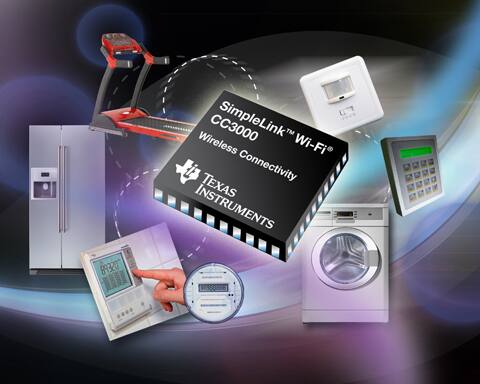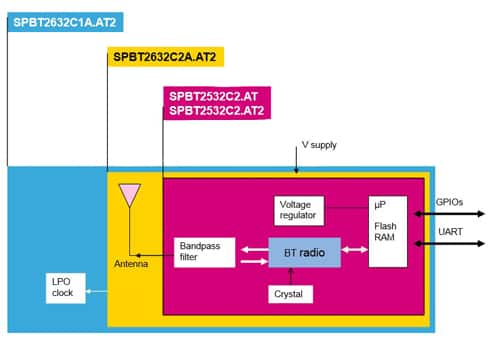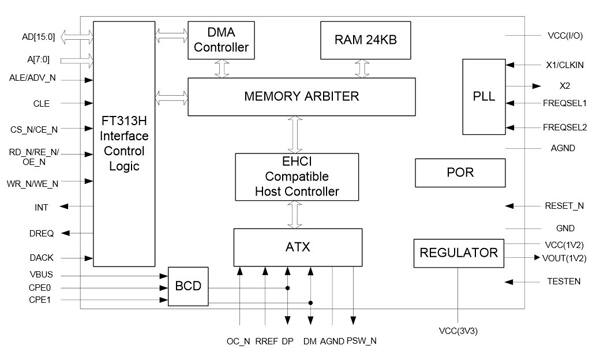Matching Wireless Power Range and Data Throughput to Application Needs
投稿人:DigiKey 欧洲编辑
2013-09-04
In today's product scene, whether the products are for the consumer sector or the professional environment, wired connections are often perceived as “last year's thing”. Consumers expect their products to connect wirelessly, and to do so transparently, without troubling the user with setup issues.
In a recent survey of design engineers, the dominant wireless standard that they expected to be included in their specifications, for products that required any form of wireless interface, was Wi-Fi. This accords with the trend to building the “internet of Things” (“IOT”); in addition to exploiting the availability of drop-in wireless solutions to implement the link, products gain their own IP address. Even if they are not, in the immediate implementation, fully joined with the IOT, products are future-proofed by being ready to join in whatever wider networked solution emerges over successive updates and upgrades.
But the wireless Ethernet connection is only one solution in a hierarchy of wireless connectivity standards and, in terms of bandwidth available from commonly implemented standards, it sits at the high end of the list. Radio links using IEEE 802.11a/b/g or /n can reach nominal speeds of 54 Mbps or even higher. Actual throughput in terms of data payload will be somewhat less, but even allowing for that fact, there are many applications that require only a fraction of that performance. For lower data rates, and lower power, there is Bluetooth. At the lower end of the connectivity spectrum sit the unpowered (or rather, powered over-the-air) technologies of near-field communications (NFC); and between those points lies a host of solutions which aim to minimize their power demand while continuing to provide data throughput in the region of 1 or 2 Mbps. These encompass the Bluetooth Low-Energy standard, the ANT+ solution from ANT Wireless, the low-power IP standard 6LoWPAN, the optimized-for-remote-controls RF4CE standard, and more. In this space sit the many standards for mesh networking, such as ZigBee, that use the IEEE 802.15.4 radio specification, or a variant of it.
Body area networks
To focus attention on the human interface function in today's product scene, Human Interface means much more than a keyboard and a display. The body-area-network (BAN) has brought a new meaning to the term and now gathers data from multiple sensors that report parameters of the human body such as heart rate, blood oxygen and blood glucose, in addition to voluntary inputs from touch screen or keypad. Products in this space frequently require a wireless interface, and Bluetooth LE is one choice. Overlaid on specifications of data rate and latency are requirements for low power, and the available air-interface chipsets and associated microcontrollers are oriented to this goal.
Bluetooth Low Energy was added to the Bluetooth specification with v4.0 in 2010, with the aim of bringing ultra-low power consumption, in peak, average and standby modes, with the ability to run for long periods (years) on coin-cell batteries. This was the Bluetooth SIG's response to the appearance of a number of proprietary standards for wireless connectivity, especially in the area of body area networks, health and fitness, and “wellness” medical monitoring products. An important distinction is that the LE variant is not simply a modified protocol of prior Bluetooth specifications; a new physical-layer (air interface) was introduced. It employs an asynchronous client/server approach and low-latency transactions are completed in a few milliseconds. This is not primarily to service low-latency traffic, rather to minimize the time for which the air interface is energized, to save power. The Bluetooth LE specification claims enhanced range over preceding and competitive solutions. A particular issue in the BAN context is the extreme variability of the short path between a wristwatch display, a chest-mounted heart-rate sensor, and a smartphone that may be collating data. Path loss may vary by tens of dB depending simply on whether or not the wearer's torso is in the line-of-transmission.
Wired is still required
This is not to forget the wired connection; a range of standard interfaces is still expected in today's products, Ethernet, USB, and FireWire. Internal product architectures continue to employ long-established serial interfaces such as I²C. Human-interface traffic may be routed over any of these; in the case of the touch interface, some microcontrollers provide for direct detection and resolution of touch by on-chip peripherals, which some acquire that data over an external link. On the other side of the human-interface equation, display controllers are required to push ever-more data to high-resolution displays. The engineer has the option of routing video directly from on-chip peripherals, or selecting appropriate dedicated-function interface chips.
CSR goes LE
Bluetooth pioneer CSR's offering for the low-energy v4.0 market is µEnergy®; its CSR1000 and 1001 chips offer +8 dBm transmit power, -92 dBm receive sensitivity, RSSI monitoring to detect proximity, and as low as 0.6 µA current in their “dormant” mode. As CSR says, although the LE variant has a (peak) data rate of 1 Mbps, this is best regarded as a 'burst' data rate over small intervals to transfer small segments of data quickly; you should not use it for larger file-size transfers. As CSR's first single-mode Bluetooth low-energy solution, CSR µEnergy enables ultra-low power connectivity and basic data transfer for applications previously limited by the power consumption, size constraints, and complexity of other wireless standards. The µEnergy platform provides everything required for the creation of a Bluetooth low-energy product with RF, baseband, microcontroller, and qualified Bluetooth v4.0 stack with capacity to run the end application, on a single chip. There are two chip variants; CSR1001 is for keyboards and remote controls with dedicated hardware for keypad scanning. The CSR1000 offers a smaller package for fitness products, watches, mice, and other sensors.
Texas Instruments
Texas Instruments has approached the issue of supporting engineers who may have limited RF design experience, with its SimpleLink™ product family; this provides a consistent method of designing-in a wireless interface across a wide range of applications. TI offers SimpleLink solutions for multiple wireless technologies including Wi-Fi, ZigBee, 6LoWPAN, and ANT. For example, its CC3000 module is a self-contained Wi-Fi solution that enables Internet connectivity for a wide variety of microcontroller systems. SimpleLink Wi-Fi minimizes the host MCU software requirements, for low-power and low-cost applications. The CC3000 EM board is targeted at TI MCUs, such as the MSP430-FR5739.

Also implemented by TI, ANT is a wireless sensor-network protocol that uses the 2.4 GHz RF band, which ANT Wireless designed for the lowest possible power. It offers peer-to-peer, star, tree, and mesh connection topologies with a small protocol stack, with low-level security features on which designers can build their own network security. ANT says that the solution gives the user sufficient control to readily configure applications, while reducing the load on a host processor to provide a simple wireless solution. The protocol has proved popular with designers of sports and medical body-area-network products, where low-battery demands and lightweight are paramount.
TI's implementation comprises the CC2570 and CC2571, respectively 1- and 8-channel ANT RF network processors. They are single-chip 2.4 GHz radios with 4 dBm output power for worldwide use, that include an accurate RSSI (received signal-strength indication) function, which can be useful for deciding when two devices are close enough to form a linked pair. They occupy a 40-pin 6 mm square package and power-down to 0.5 to 1.0 µA from a 2 to 3.6 V supply. The radio chips connect via a UART or SPI interface to a host microcontroller such as a TI MSP430, and are controlled by API calls. Most of the ANT protocol is embedded in the CC2570/71, including the ANT-FS file system, leaving the MCU to handle application and profile layers. Profiles, in the ANT world, comprise concepts such as bicycle-power profile for sports accessories. This keeps the demands on MCU memory to a minimum. The ANT protocol is both power-efficient and flexible, handling multiple configurations. Each logical ANT channel can be independently configured for one- or two-way operation, depending on the application requirements.
TI similarly offers SimpleLink 6LoPAN (CC1180), ZigBee (CC2530) and Bluetooth Low-Energy (CC2541) variants, as well as a Wi-Fi module that includes SmartConfig, a single-step Wi-Fi activation process.
Atmel builds on low-power MCUs
Atmel has a range of wireless transceivers for Wi-Fi and lower-power standards, and has recently expanded its presence in the sector by making company acquisitions and partnerships. Late 2012, it announced a collaboration with Redpine Signals to provide ultra-low-power 802.11n Wi-Fi capability for AVR and ARM®-based MCUs. Engineers can implement 802.11n Wi-Fi to all Atmel AVR and ARM-based MCUs using Redpine Signals' modules. System engineers for Atmel AVR XMEGA and AVR UC3 MCU families and Atmel SAM3 and SAM9 ARM-based MCU families can now integrate Wi-Fi capability for a variety of embedded systems in building automation, metering, digital audio, and medical applications. Atmel customers can add 802.11a/b/g/n Wi-Fi connectivity with fully-certified solutions and integrated TCP/IP stack, which are optimized for Atmel MCUs such as the AVR® XMEGA™ and AVR UC3 MCUs, SAM3 ARM-based MCUs, and SAM9 ARM-based MCUs.
More recently, Atmel moved to expand its position in ultra-low-power Wi-Fi by acquiring Ozmo, a source of ultra-low-power Wi-Fi solutions that will expand Atmel’s wireless offerings for smart, connected devices, including devices targeted to the “Internet of Things". Added to Atmel’s wireless portfolio, Ozmo brings "Wi-Fi Direct" certified technologies that will accelerate seamless communication and connectivity across wireless personal area networks (WPANs). Designed for consumer electronics products requiring smaller form factors and longer battery life, including gaming peripherals, HD audio speakers, portable audio headsets, digital thermostats, appliances, and CE remotes, these Wi-Fi products and technology offer developers ultra-low-power, cost-effective solutions for connecting fixed and portable peripheral devices with Wi-Fi platforms.
Atmel's existing range includes single-chip Wi-Fi solutions that allow battery-powered devices such as remote controls, cordless mouse/keyboard products, and headsets/speakers, to communicate directly with many Wi-Fi-enabled devices. In this way, a host product's existing Wi-Fi device can provide concurrent WLAN and WPAN functions. This convergence delivers cost savings for systems developers and solves integration and coexistence problems associated with legacy WPAN approaches like Bluetooth and proprietary technologies. Parts such as the AT86RF232 RF transceiver, a high-performance RF-CMOS 2.4 GHz transceiver for 802.15.4, ZigBee, RF4CE, 6LoPAN and other ISM-band applications, have a receive sensitivity of -100 dBm and programmable power output of -17 to +3 dBm. It uses a maximum of 13.8 mA in transmit, and shuts down to a sleep-mode current of 0.4 µA. It includes logic to buffer data traffic and is reached via a serial bus, and it hosts hardware assistance for the IEEE 802.15.4-2011 specification.
Silicon Labs in the sub-GHz
Silicon Labs has focused on the lower part of the spectrum for ISM operation, with its EZRadioPro® series of devices for use from 240-960 MHz, as local regulation permits. The Si102x/Si103x wireless microcontroller (MCU) family combines the ultra-low-power C8051F96x MCU core with the Si443x EZRadioPRO transceiver into a single-chip solution, an example part is the SI1021 with 64 kB of on-chip memory. It addresses the requirements of low-power embedded systems requiring an RF link. By reducing overall system power, these devices enable developers to either reduce the size/cost of batteries or increase battery life while delivering end products with excellent RF performance. The Si102x/3x families offer high receive sensitivity, low power consumption in both receive and transmit modes, high data rates, antenna diversity and frequency hopping capability. The 8051 MCU core is a modern pipelined implementation that provides up to 25 MIPS; the EZRadioPRO architecture has on-board digital modulation/demodulation and connects directly to the digital I/O of the MCU.

Microchip Technology
Also in the sub-1 GHz band is a series of products from Microchip, ultra-low-power ISM band integrated transceivers, such as the MRF89XA. The MRF89XA is a single chip, multi-channel FSK/OOK transceiver that spans the 863-870 MHz and 902-928 MHz license-free ISM frequency bands (as available), as well as the 950-960 MHz frequency band. Microchip optimized the design of the MRF89XA for very-low-power consumption; it uses 3 mA in receive mode and 25 mA in transmit, at an output of +10 dBm. It can be placed in standby for a power drain in the region 0.1 to 2 µA. It incorporates a baseband modem with data rates up to 200 kbps, and interfaces via a simple 4-wire SPI connection. Data handling features include a 64-byte FIFO, packet handling, automatic CRC generation, and data whitening. Its highly-integrated architecture allows for minimum external component count while still maintaining design flexibility. Similarly, Microchip produces a series of certified modules for the 2.4 GHz band, based around its MRF24J40 802.15.4 transceiver IC.
ST's micro Bluetooth module
Among suppliers of Bluetooth modules for the standard (version 2.1) specification is STMicroelectronics. The SPBT2532 is a micro-sized Blue Module that offers the most advanced Bluetooth technology on a highly-reliable and affordable platform. It provides fast data throughput of up to 2 Mbps with the EDR enhancement, and employs the adaptive frequency hopping defined in version 2.1. It has a variety of serial interface options (fast UART, SPI, I²C) and includes a 12-bit A/D input so that users can directly feed measured values out to the RF link. On a small form factor (10 mm x 13 mm footprint) the SPBT2532 is a standalone solution for users requiring a simple wireless link by establishing a wireless bridge between a device and any other Bluetooth-enabled device. They can be used in applications such as notebook PCs and accessories, PDAs, access points and industrial controls, as well as for portable medical equipment.

USB for wired backup, and charging
In choosing examples from DigiKey's offering in each of these segments of the wireless scene, it is important not to completely forget the wired option. Despite their low-power operation, many portable products now in design will still have rechargeable cells to power them. The default connector to do so has now become micro-USB, and if providing a USB port, it will add only a small increment to the bill-of-materials to make that a powerful data channel. The normal mode of operation may be over-the-air, but a wired connection is appropriate for bulk data transfers, or periodic updates. FTDI's Vinculum-II embedded dual USB host controller is configurable for virtually any USB 2.0 embedded application, and its integrated processor core, a 16-bit Harvard-architecture design, comes with a complete supporting tool chain to develop additional application features. The chip will handle most aspects of the USB data transfer, with a complement of data RAM (16 kB) and FIFO interface, freeing up a host processor, or avoiding waking it entirely.


免责声明:各个作者和/或论坛参与者在本网站发表的观点、看法和意见不代表 DigiKey 的观点、看法和意见,也不代表 DigiKey 官方政策。







 中国
中国